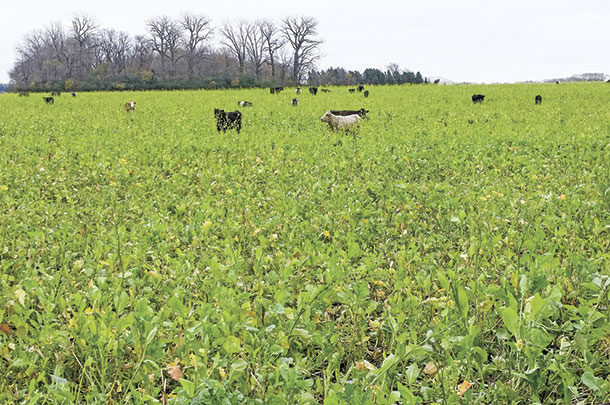Although 17 species may seem like a lot and makes for a very colorful drill, Tom Cotter says the benefits he gets in his fields and with his cattle from such diversity outweighs the ease of having a less “complicated” mix.
“One thing I like about the 17-way blend is: in my fields, I have dry spots, and I have wet spots. Some species do better in wet, and some do better in dry – so when you have a blend of different varieties, the whole field grows better,” he says.

Cotter Farms, made up of Tom Cotter; his father, Mike Cotter; and his uncle’s estate, encompasses 1,100 acres of sweet and silage corn, canning vegetables and their cow-calf herd. They use cover crops on 100 percent of their acres.
Not really purposely planting a “cover crop” per se, Tom Cotter’s journey in cover crops started when he followed peas with rapeseed as a weed control before corn. “I didn’t really think about it until the following year, when the corn came off really good in that spot,” Tom Cotter says.
The mix he uses today is twofold: First and foremost, it’s for the cattle, but it also benefits the soil and the succeeding crop. He interseeds this mix around Aug. 1 into corn but says anywhere from mid-July to mid-August would work fine for fall grazing. They also have another mix they graze in the spring.
“If we were just going to do a soil health program, this mix would look a little different,” he says. “I will say my calves have never come off of grazing looking that good. I pulled them off on Jan. 3, and they were the best calves I’ve ever had.
But then, also, this spring we were checking out the field, and we pulled up a clump of dirt the size of a football, and on that slab were 25 worms – and then you would break it apart and find 10 more worms. When you have the soil health going so good, it’s incredible.”
One of the species he speaks highly of is bayou kale. He says the cows really like it, and it stands erect so when it snows, it’s easy for the cows to get to.
However, he has to be cautious of not overloading the mix with brassicas – since they are high in micronutrients and sulfur, which in large amounts can be detrimental to cattle. “That’s why we use multiple species at lower rates,” he says.
Referring to the brassicas, Cotter says you don’t want to overseed too many pounds because as they grow, they will shade out the rest of the mix. He says at first the cows would start with the grasses and slowly move to the brassicas, but after turning them into the second paddock in November, they actually ate the brassicas sooner.
“I think every plant is bringing up different minerals, different nutrients and different things at different times. I might not know it, but my cattle do.”
To prove it, he notes he had a 250-pound mineral tub out in the paddock with about 87 head. He says that tub lasted two months and still had a little less than half left in it. “Having that 17-way mix lets them pick and choose what they need to balance their nutrients,” he says. “It’s really quite amazing.” ![]()
PHOTO 1: “I think every plant is bringing up different minerals, different nutrients and different things at different times. I might not know it, but my cattle do.” Photo provided by Tom Cotter.
PHOTO 2: Seed photos generously provided by Green Cover Seed.

-
Cassidy Woolsey
- Editor
- Progressive Forage
- Email Cassidy Woolsey













